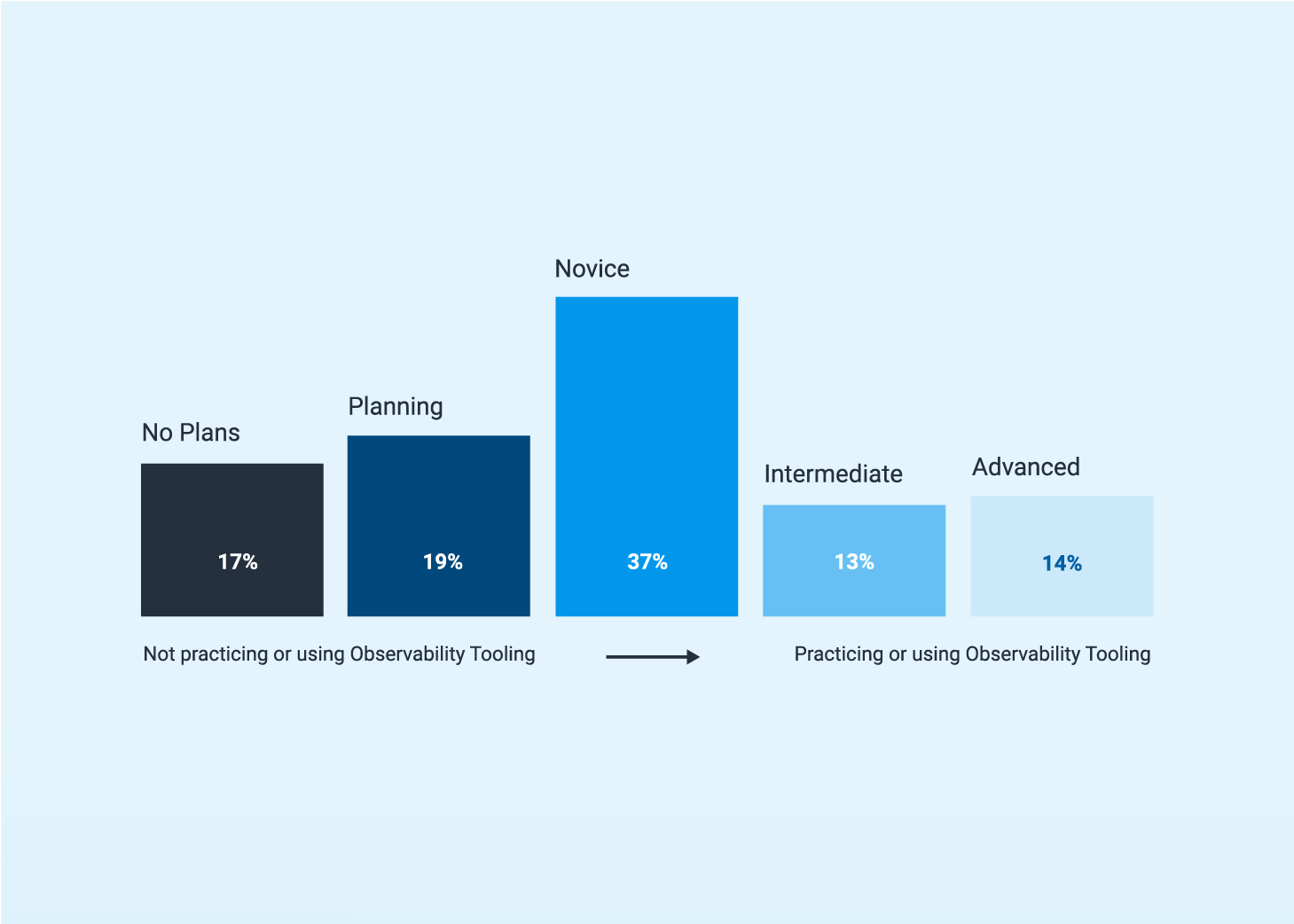Latest research reveals organizations that embrace observability experience higher productivity, code quality, end-user satisfaction, and software developer retention
SAN FRANCISCO, June 16, 2021 – Honeycomb, which provides industry-leading observability software for understanding, troubleshooting, and optimizing cloud-native distributed systems, today released its annual research findings on the maturity of the observability market. The 2021 survey found that 61% of respondents reported that their teams are practicing observability, an 8% increase from 2020, signaling that overall adoption is on the rise. However, the majority of respondents indicated their teams are at the earliest stages of observability maturity.
With over 400 responses from across multiple industries and organization sizes, the report examines the challenges teams face and the practices they are implementing as they progress on their observability journey to achieve production excellence.
Key findings include:
- Observability is gaining traction. Sixty-one percent of respondents reported that their teams are currently practicing observability, an increase of 8% from last year. That increase is sharply reflected across individual teams (up 7%) as opposed to entire organizations (up only 1%).
- Teams on the higher end of the maturity spectrum realize more benefits than their less-mature counterparts. Teams that are mature in their observability practice realize even more impactful business outcomes, including deploying more frequently, being able to find bugs more quickly before and after pushing to production, and reduced burnout.
- More-mature teams are also 3X more likely to deliver higher customer satisfaction. Teams that have achieved Intermediate or Advanced-level maturity reported their end-user customers are “Always Satisfied” with their service quality and capability at a rate of three times more than teams that do not practice observability.
- Lack of implementation skills is a disproportionate barrier for observability adoption. While interest in observability has gained significant momentum, organizations at the earliest stages of observability maturity report lack of implementation skills as the second-largest hurdle to observability adoption, indicating a need for more training options. All respondents indicated their primary hurdle was competing with other initiatives.
Now in its second year, the 2021 Observability Maturity Community Research Findings is becoming a benchmark that organizations can use to measure their own journey to observability and related practices against that of the wider business community. The maturity model outlines a progression of five distinct stages ranging from “Planning” or “Novice” (with limited observability capability and processes) to “Advanced” (with comprehensive processes). The highlights of this year’s report indicate that:
- 10% of those surveyed reported a combination of practices and tooling that reflect a highly observable system in the “Advanced” and “Intermediate” groups. These two groups highly prioritize observability: 50% practice observability across the organization and 43% on a team-by-team basis. Respondents also reported high public cloud use, and most work at large enterprises (57%) and in the tech industry (46%).
- 37% of survey respondents fall into the “Novice” group. This group is more likely to self-report that they are practicing observability because they are using tools like logs, metrics, and traces. However, they also do not report having the key capabilities associated with practicing observability, such as having a comprehensive understanding of their systems, which suggests that respondents in this group may be focusing on the data needed for observability but not yet fully adopting the tools or practices of observability.
- One in four teams are at the “Planning” stage or the very beginning of their observability journey and are starting to practice on a team-by-team basis. In this group, approximately one in five respondents do not currently practice or use observability tooling but have plans to do so within the next year.
“This year, we’re seeing that teams focused on building up their observability capabilities are identifying problems faster and producing better business outcomes,” said Christine Yen, CEO and co-founder of Honeycomb. “Our observability maturity model can be used as a roadmap for anyone to see how organizations across the industry are approaching a fundamentally new way of understanding their production services. Teams can understand what’s working, what’s not, and how early investments in observability adoption are creating meaningful business impacts, so that they can achieve similar results.“
Additional Resources
On Tuesday, June 29, at 12 p.m. ET / 9 a.m. PT, join our webinar, “The State of Observability 2021: Mature Teams Ship Better Code Faster and You Can, Too,” to discuss the findings of this report and hear actionable insights that organizations can use to start or improve their observability approach. Reserve your seat by registering for the webinar.
To receive a copy of the report, please visit this page.
The 2021 Observability Maturity Community Research Findings study was conducted by ClearPath Strategies, an independent strategic consulting and public opinion research firm.
About Honeycomb
Honeycomb provides observability for modern development teams to learn, debug, and improve their production systems efficiently so that business-critical apps perform with minimal disruption to users. Honeycomb’s customers rely on the product for fast incident response, system optimization, and delivering pain-free releases across the software engineering cycle that translates to happy devs and happy customers. Learn more at www.honeycomb.io and follow us on Twitter.
Contact:
George Miranda
(512) 481-2876








